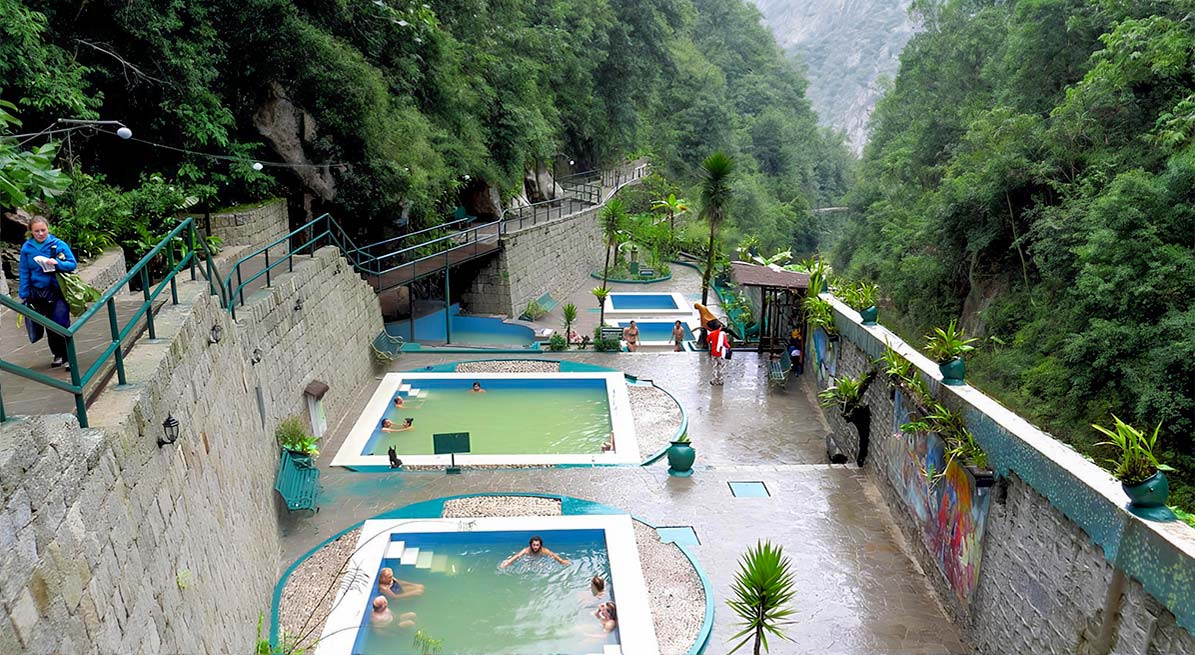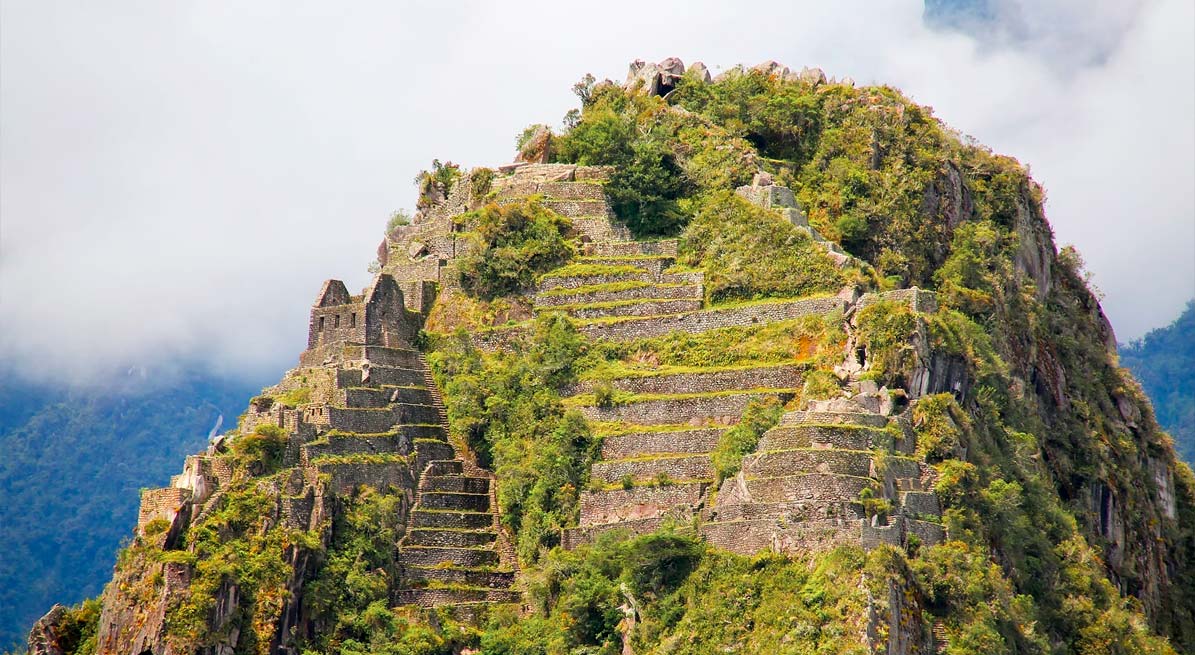Every day, thousands of people from all over the world come to the town of Aguas Calientes in search of the wonder of Machu Picchu. This mixture of ideas, cultures, nationalities, religions, etc., have turned this small town into one of the most cosmopolitan places in the world.
It is a small town of 3,400 resident inhabitants and an average of 1,500 tourists a day, where the urban and commercial area is located and is the obligatory step to visit the Inca citadel of Machu Picchu.
It has hotels and restaurants for tourists, the train station, craft markets, thermal baths and basic public services.
All travelers to and from the Inca citadel of Machu Picchu, must pass through here. It is 6 kilometers (3.7 miles) away, about a 1h30 'walk to the archaeological site.
Where is Aguas Calientes?
Machupicchu town, also called Aguas Calientes, is a Peruvian town located in the department of Cusco, Urubamba province, Machu Picchu district. It is the capital of the homonymous district, where the District Municipality is based. It is the main access road to the Historic Sanctuary of Machu Picchu.
Aguas Calientes is the small cosmopolitan city located just below Machu Picchu. It is known as Machu Picchu town due to its proximity to the Inca City.
It is located 112 km northwest from the city of Cuzco, in the Urubamba Valley, in the lower part of the Sacred Valley of the Incas. It is 6 kilometers away, about 1h30 'walk, from the archaeological zone.
At what altitude is the town of Aguas Calientes?
The altitude of Aguas Calientes is 2,300 meters above sea level (6,692 feet).
At the altitude of Aguas Calientes, no tourist suffers from altitude sickness.
Can I feel altitude sickness in Aguas Calientes?
No! The altitude of Aguas Calientes is only 2 040 meters above sea level and normally the effects of height can be felt from 2 300 meters.
By way of comparison, Machu Picchu rises to 2,430 meters, Huayna Picchu, 2,693 meters and Cusco, 3,399 meters.
Either way, in high places, you should walk more calmly than usual to avoid suffocating quickly.
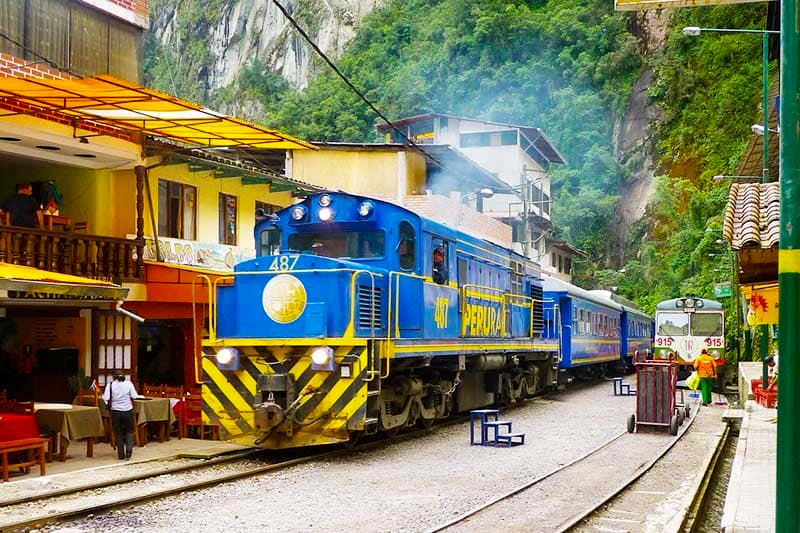
History of Aguas Calientes
Its origins go back to the year 1901, the year in which the construction of the railway began to unite the towns of Cusco and Santa Ana, province of La Convencion. In 1928 the railway reached the Maquinachayoq camp area, a place that became the center of operations for the project's machinery and heavy equipment, around which the railway workers settled.
Originally inhabited by a few farming families until 1901, it was also a small settlement that was transformed into a railway workers' camp, called Campamento Maquinachayoq, until the late 1920s. This population was the central axis for the accommodation of workers and their equipment until that the railway was completed in 1931.
Currently, the declaration of the Historic Sanctuary of Machu Picchu as one of the new seven wonders of the modern world (2007), the celebration of the Centennial of its Scientific Discovery (2011) and the worldwide election of Peru as the first tourist destination, constitute facts and events that have directly and significantly stimulated the tourist development of the district.
Geography
The Urubamba River and the town of Aguas Calientes, seen from the path that leads to Machu Picchu.
Machu Picchu town is located in the yunga-fluvial or yunga region of the jungle, at an altitude of 2040 meters above sea level. The town is located on the banks of the Urubamba River, at the mouth of the Aguas Calientes and Alcamayo rivers towards the first. Machu Picchu is surrounded by granite mountains covered with abundant vegetation typical of the region of the high jungle or jungle eyebrow.
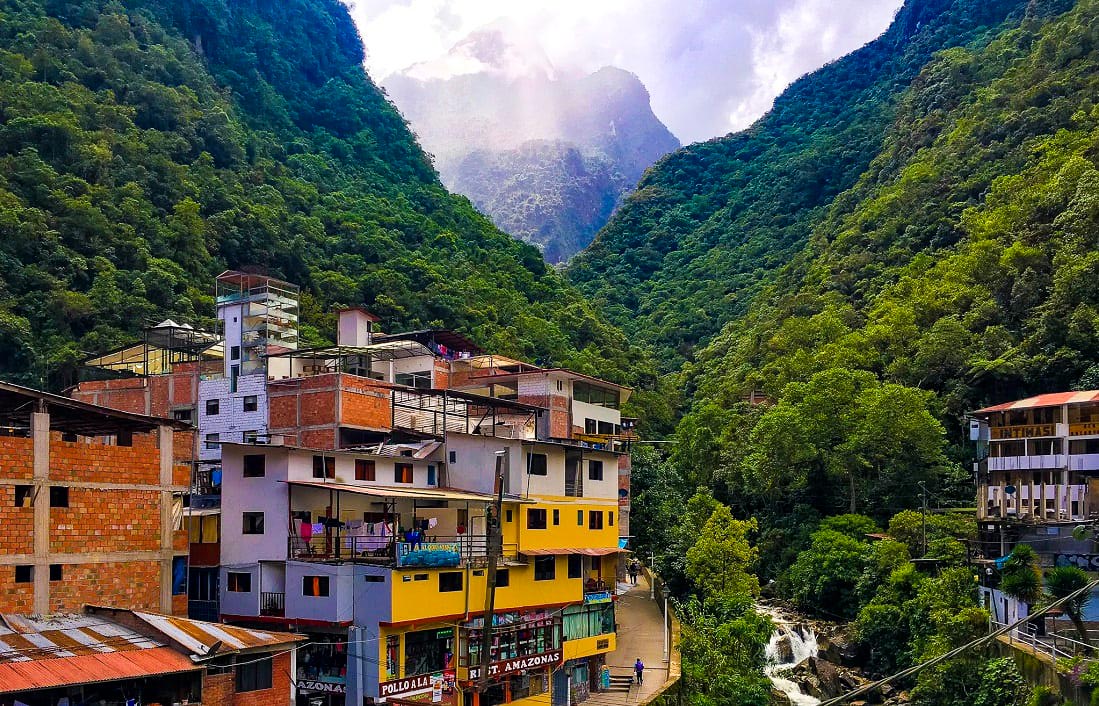
Weather in Aguas Calientes Perú
The weather in Aguas Calientes Perú is warm-temperate with a high percentage of humidity. The average temperature is 16 ° C (60.5 °F). The weather in Aguas Calientes Perú is relatively mild throughout the year, with heavy rains from November to March, and hot and dry weather from April to October, which is a recommended time to visit. The minimum annual temperature ranges from 8 °C to 11.2 °C. In the months of June, July and August the temperature can drop below zero. The maximum annual temperature varies from 20.4 °C to 26.6 °C.
The terrain is quite uneven, with many ravines and streams fed by glaciers that usually flow into the Urubamba River, which crosses the area forming a deep valley that extends through the granite base of Vilcabamba for more than 40 km through a variety of ecosystems.
Demography
Machu Picchu town has a population of 4525 people according to the 2017 Peruvian Census.
The population has access to public services of water, drainage and electric lighting in its entirety, and it also has a solid waste collection service on a daily basis.
What to do in Aguas Calientes
Due to its geographical location, just 9 kilometers from the Historic Sanctuary of Machu Picchu, it is the place where tourists who visit the Inca city arrive.
The town has developed an important tourist and hotel infrastructure from simple accommodation to exclusive hotels.
Maybe you are asking what to do in Aguas Calientes? Well, among its most important tourist attractions are the thermal baths located 800 m from the town, which are attributed medicinal properties.
Other nearby tourist attractions are the Mandor waterfall, 3 km from the town, following the railway line in a northwesterly direction; the Manuel Chávez Ballón Site Museum, located on the road to the Historic Sanctuary of Machu Picchu, 2 km from the town; In addition, the town has an artisan market next to the train station.
Here I share you what to do in Aguas Calientes and places to see in the Machu Picchu Town and its surroundings:
Relax in the hot springs of Aguas Calientes
The town of Aguas Calientes justly gets its name from its hot springs. The hot springs of Aguas Calientes is a complex of 5 pools of sulphurous water (many think that the water is dirty because of its yellowish color, but it is the sulfur that gives them its peculiar color) with a temperature that ranges between 38°C and 46°C. The waters of the hot springs of Aguas Calientes are natural and come directly from various sources of volcanic origin and possess numerous therapeutic properties.
- Entrance: 20 soles
- Hours: 05:00 a.m. - 8:00 p.m.
Explore the Mandor Gardens
Walking about 50 minutes through the humid forest, following the train tracks to Santa Teresa, we arrived at a magnificent green oasis called Jardines de Mandor; where it is said that Hiram Bingham may have started his expedition.
This nature reserve is a true paradise to walk and admire the wild flora and fauna, which will also amaze you with its imposing waterfall.
Also a great place for bird watching, where you will find numerous orchids and hummingbirds, in addition to the famous cock of the rocks, the national bird of Peru (also called cock of the mountains, cock of Peña Andino or Tunqui). If you like bird watching, you should know that the best time to do it is the dry season, from April to October.
- Entrance: 10 soles
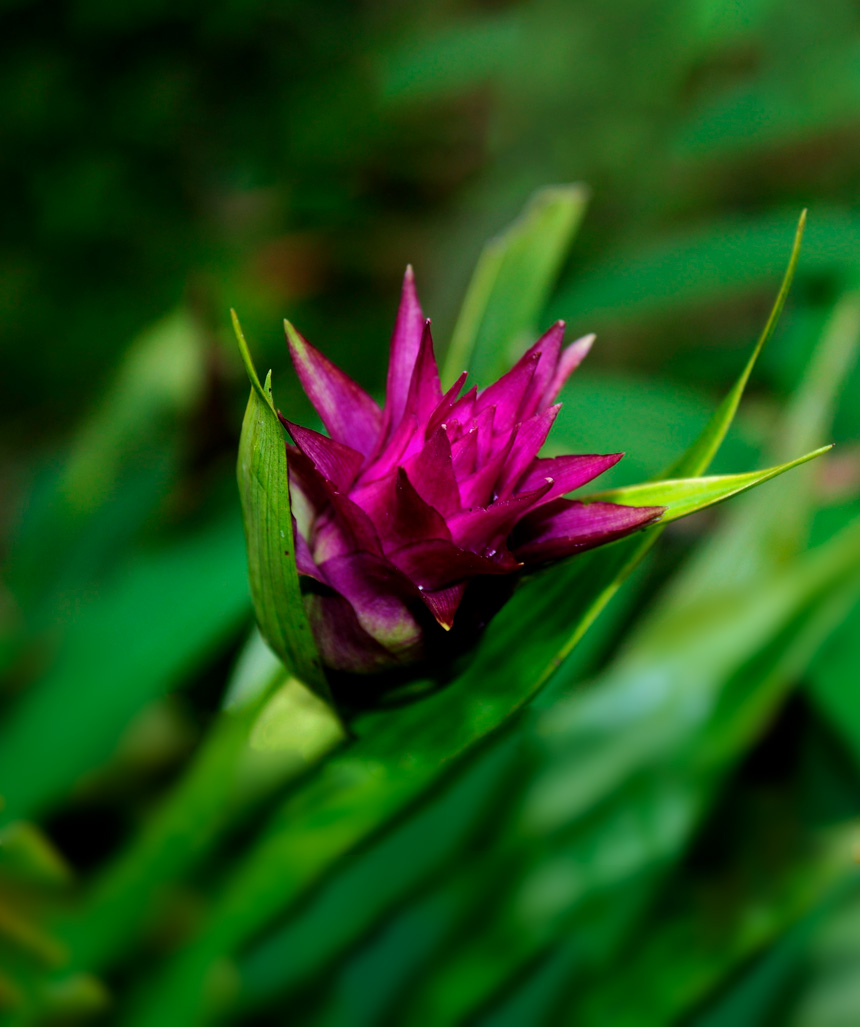 |
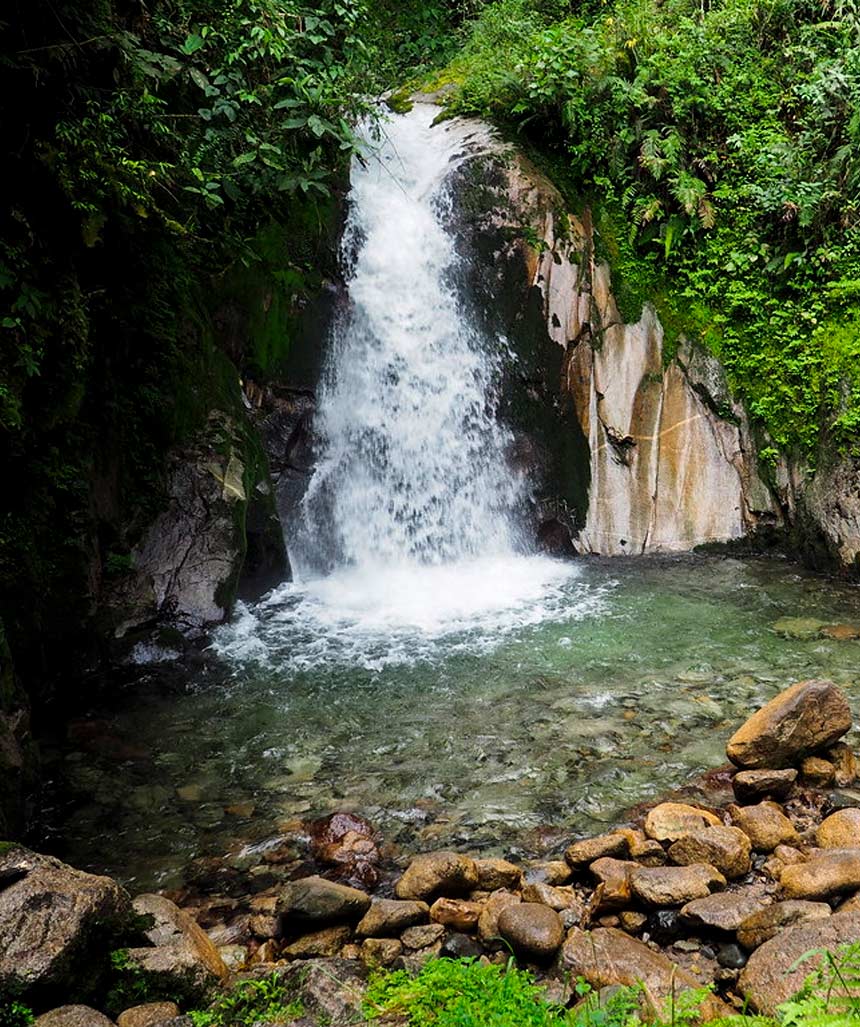 |
Discover the Machu Picchu museum
It has two exhibitions and a botanical garden:
An exhibition on the Inca remains found in Machu Picchu and surrounding areas: around 250 objects, including ceramics, bronze and copper tools, skeletons and different objects used in Machu Picchu.
An exhibition of the Inca artifacts for construction that allow us to understand how the citadel was built.
A botanical garden with more than 200 types of orchids, most of which are endemic to the region.
It is a very interesting visit, and it is even more so if you have not brought a guide for your visit to Machu Picchu.
To get there you have to take the Hermanos Ayar Avenue, from the Hiram Bingham road (about 30 min on foot)
- Entrance: 22 soles
- Hours: 09:00 a.m. - 4:30 p.m.
 |
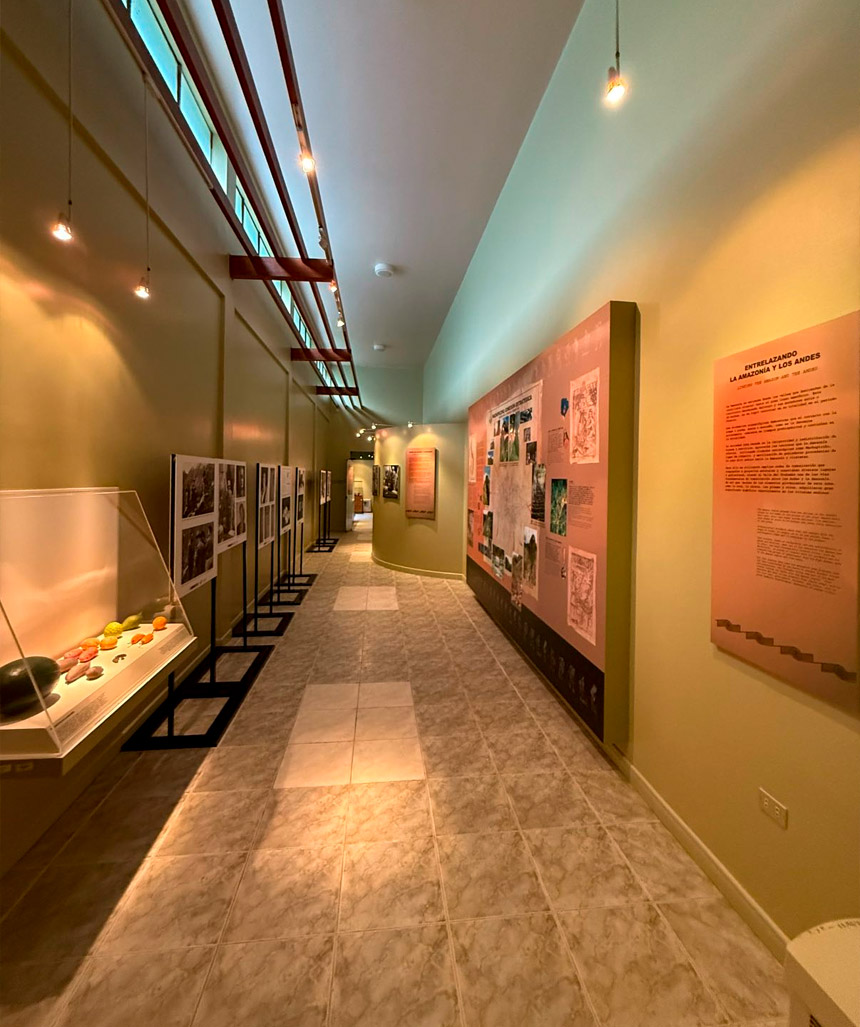 |
Marvel at a multitude of butterflies
A 25-minute walk from Aguas Calientes, taking the bus route to Machu Picchu, is the Mariposario, a butterfly farm that houses an interesting collection of live butterflies, in addition to the different stages of development.
The site is run by volunteers and aims to protect the 300 species of butterflies found in the surroundings.
To get to the Butterfly Park, it is necessary to walk to the municipal camp before the "Puente Ruinas" in the direction of Machu Picchu.
- Entrance: 10 soles
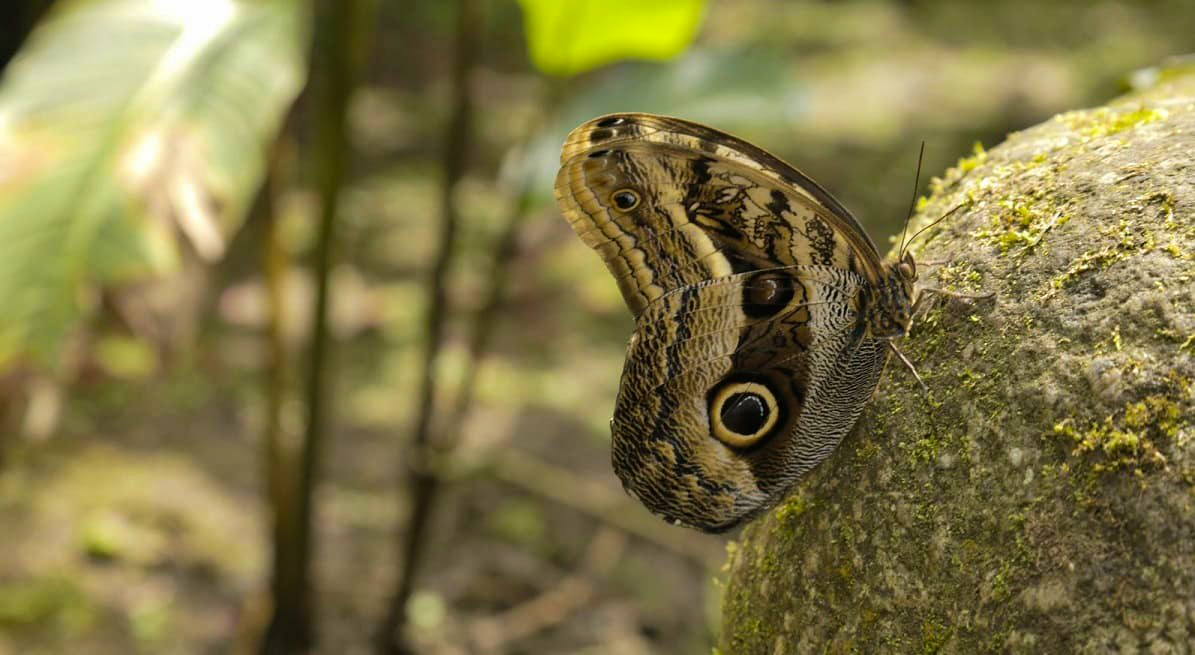
Bathing in a waterfall surrounded by nature
There is a place completely separated from the common roads and easily accessible: the Allcamayo falls. I know it's a little hard to believe that this exists in such a touristy place as Aguas Calientes, but it's true.
There you can enjoy a walk among the trees, orchids, butterflies and birds, which will finally lead you to three natural waterfalls; the last one, Allcamayo, which is also the highest (30 meters). Without a doubt, a fantastic environment to discover and enjoy in peace within the heart of nature. If you want to bathe in its waters, don't forget to bring a towel and a bathing suit.
To get there, you have to take the path behind the train station and walk about 40 minutes. You will have to climb a wooden staircase, following the path for a few minutes until you reach a cabin that says "Allcamayo Waterfall", where you will have to pay the entrance fee of 10 soles.
- Hours: 08:00 hrs - 17:00 hrs
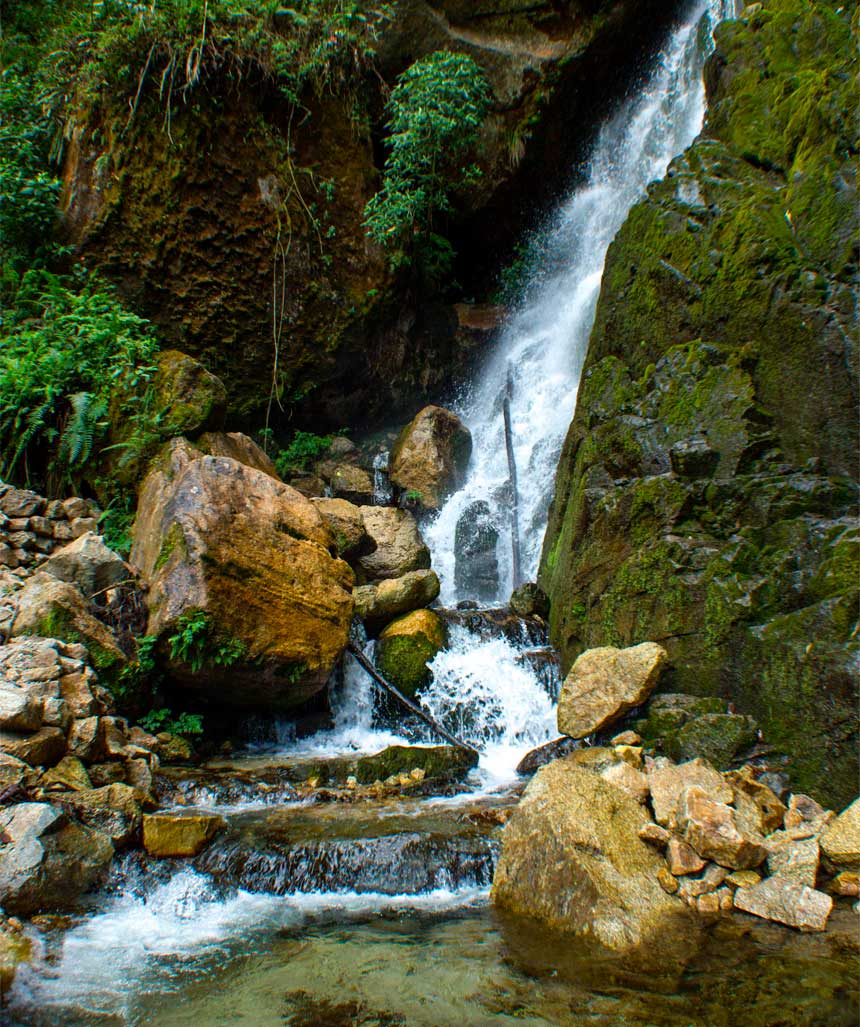 |
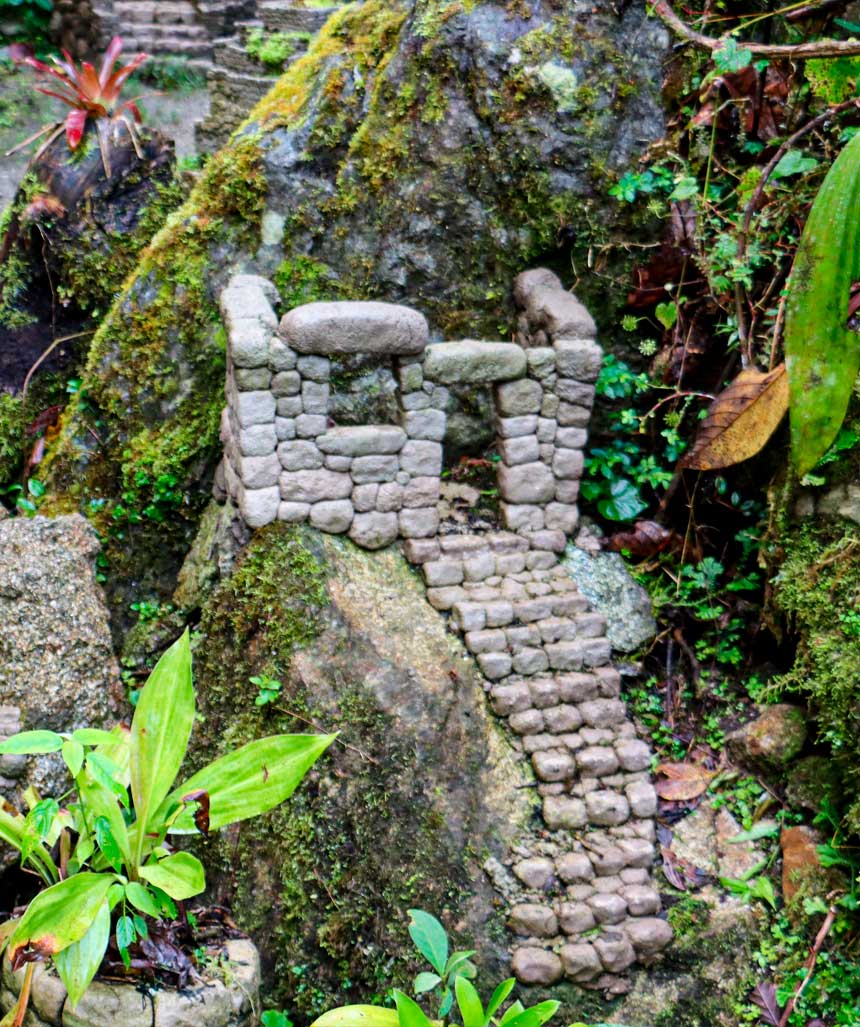 |
See Machu Picchu for free
Access to Machu Picchu is very controlled, so it is not possible to visit it for free, but it is possible to take a good look at the beautiful landscape of the citadel from Putucusi.
Phutuq K’usi, a happy mountain in Quechua, also known as the guardian of Machu Picchu, is the only free mountain that is part of the historic sanctuary of Machu Picchu.
But be careful: it is a real feat to reach the top! You have to be fit, be agile and, above all, not suffer from vertigo, because you have to climb, and descend!, On a completely vertical wooden staircase.
As its access is free, it is not exactly well preserved. Before starting the ascent, you must be well informed about the state of the trails in Aguas Calientes.
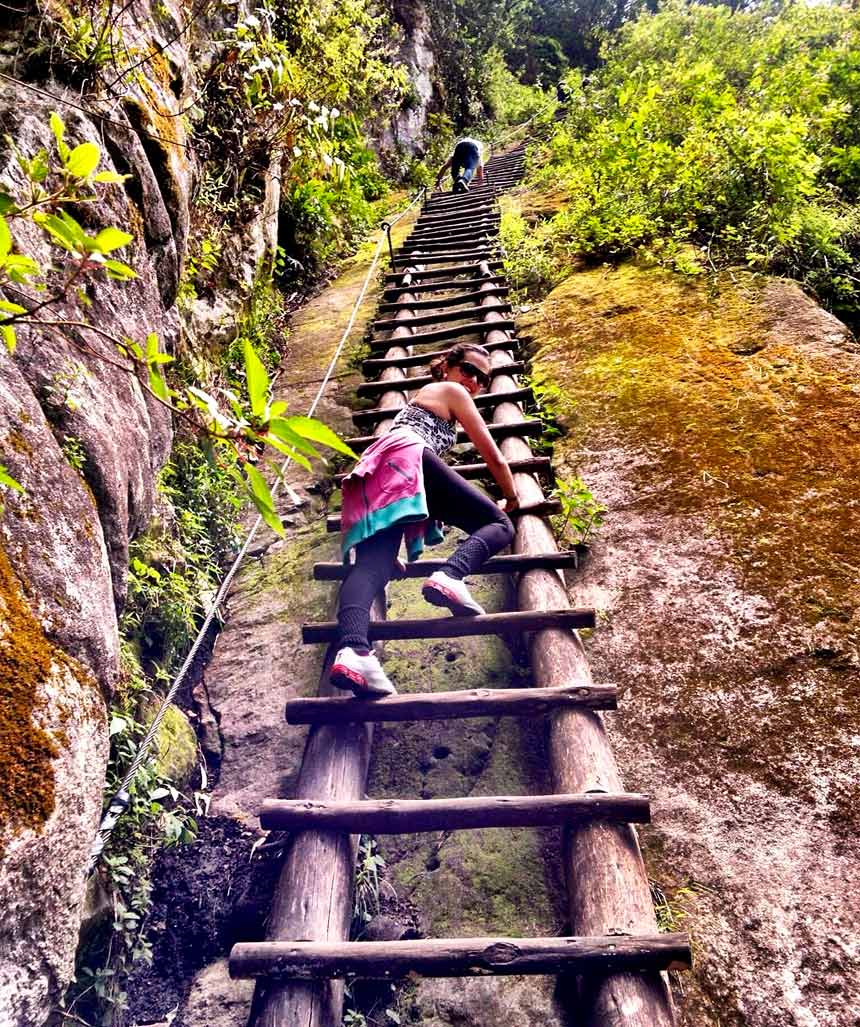 |
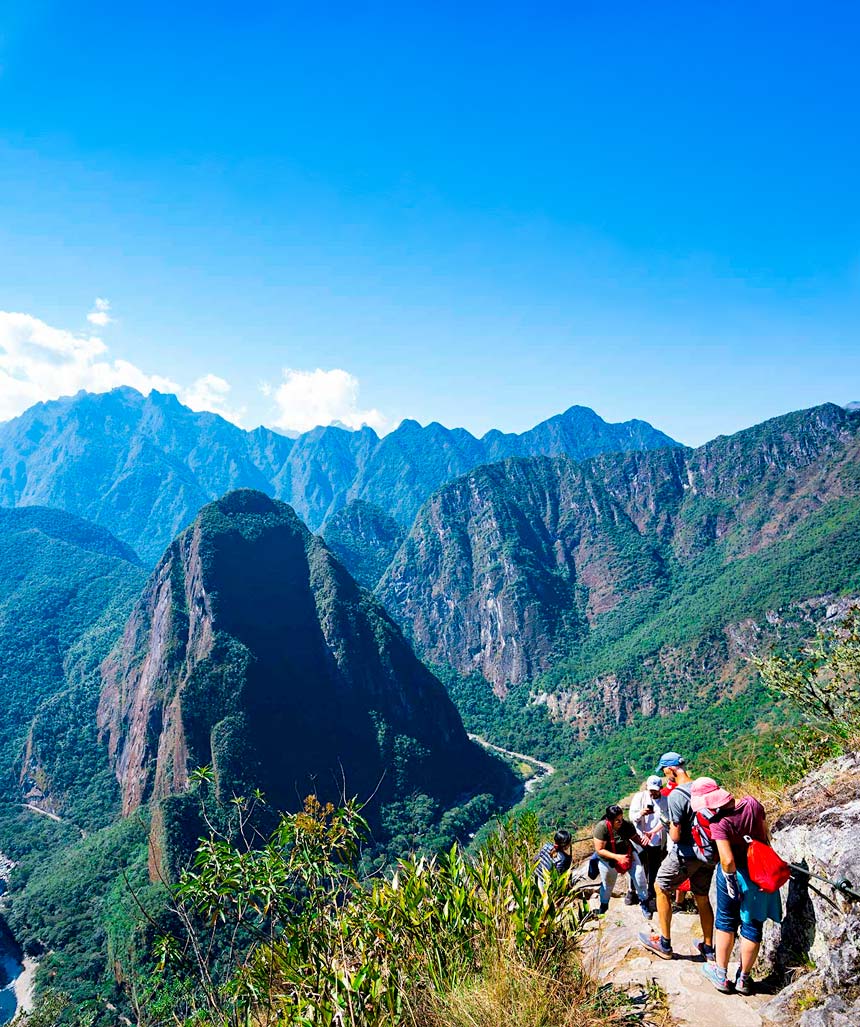 |
Climb Huayna Picchu
Huayna Picchu, "young mountain" in Quechua, is the famous mountain that is behind the citadel and that can be seen in all the typical photos of Machu Picchu.
The ascent is quite short (1.30 - 2 hours round trip), but very steep and allows a magnificent view of the place and surroundings.
A truly unique experience, which makes it so popular. Its access is quite restricted and it takes several months in advance to get a ticket.
Machu Picchu mountain, an alternative to Huayna Picchu
This is the mountain located on the other side of the citadel, in front of Wayna Picchu, and its ascent is a little longer (2 to 3 hours round trip), but less demanding.
But be careful, although it is less popular than Huayna Picchu, you will also need to book at least several weeks in advance. The ticket for the Machu Picchu Mountain is purchased at the Machu Picchu site.
Visit Machu Picchu
Hidden among the high mountains of the green Urubamba Valley, the famous citadel of Machu Picchu, seat of the highest administrative and religious functions, and home to the Inca Pachacutec palace, thanks to its location, was surely of vital importance during the empire.
The Inca city was revealed to the world until 1911, thanks to the expedition of Hiram Bingham and today it is considered the largest symbol of Peru.
Obviously, Machu Picchu is a very popular attraction and tickets sell out quickly, so I recommend you avoid buying your tickets at the last minute.
If you only want the ticket to Machu Picchu, here is how to get it:
- The offices of the Regional Directorate of Culture in Cusco (Casa Garcilaso - Calle Garcilaso s / n Cusco) or in Aguas Calientes (Av. Pachacutec)
- On the official website of Machu Picchu
Buy souvenirs
Head towards the craft market. It will be practically impossible for you not to see it, as it is located right next to the train station.
In the market you will find more than 200 kiosks with objects of all kinds: ponchos, key chains, sculptures, instruments, paintings, etc.
The craft market is open every day from 8 a.m. to 9 p.m.
Walk through the streets of Aguas Calientes
If you have a little time before or after visiting Machu Picchu, there are some things you can do on your way through Aguas Calientes: see the small church of the Virgen del Carmen, visit the main square Manco Cápac and stop by the Mercado de Abastos Even if you don't go there to eat, it is a truly local and pleasant experience.
How to get from Cusco to Aguas Calientes by train?
There is no way to town, so you have to get from Cusco to Aguas Calientes by train or on foot. Below I explain how:
To go from Cusco to Aguas Calientes:
Cusco to Aguas Calientes by train: about 3 hours from Cusco (Poroy or Wanchaq station, depending on the season) with Peru Rail. Prices from 80 US dollars, depending on the category of train you choose: Expedition, Vistadome or Belmond Hiram Bingham deluxe (with transfer from Cusco, food and show, ticket to Machu Picchu with guided tour and tea time at the Belmond Sanctuary Lodge).
Cusco to Aguas Calientes on foot: the most direct way is to take a bus to Hidroeléctrica (7 hours - 70 soles), then walk to Aguas Calientes (around 2.30 hours) following the train tracks. It is best to buy the round ticket to return from Aguas Calientes to Cusco with the same transport (departures around 2:00 p.m.).
To go from Ollantaytambo to Aguas Calientes:
Since Ollantaytambo is closer to Aguas Calientes, the train journey lasts only 1.30 hours, either with Peru Rail or Inca Rail.
Also, you can get to Aguas Calientes and Machu Picchu from Cusco, choosing the following routes of the Inca trail: 4 day Inca Trail Tour, 2 day Inca Trail, Machu Picchu 3 day hike, 2 day Inca Trail with camping, one day Inca Trail.
Alternative Treks to Inca Trail
- Lares Trek to Machu Picchu
- Salkantay Trek
- Inca Jungle Trek
- Lares Trek
- Choquequirao Trek 5 Days
- Choquequirao to Machu Picchu Trek
How to get from Aguas Calientes to Machu Picchu?
There are two ways to get there:
Aguas Calientes to Machu Picchu Hike
Are you in good physical shape? If you dare to challenge yourself to hike up to Machu Picchu from Aguas Calientes, you should know that you have approximately an hour and a half or two hours of walking uphill.
To hike From Aguas Calientes to Machu Picchu you must take the road that goes to the citadel and as soon as you reach the base of the mountain you will find the sign indicating some stairs up ... the path is very well signposted so you will not get lost on your ascent.
The path of the hike from Aguas Calientes to Machu Picchu is very well marked, but the road is not particularly interesting, but, above all, it is quite dusty due to all the buses that pass.
The descent will also take you about an hour and keep in mind the time when the sun goes down (around 6pm), so that the darkness does not catch you going down the mountain!
The bus is definitely the best option (unless your budget is really tight).
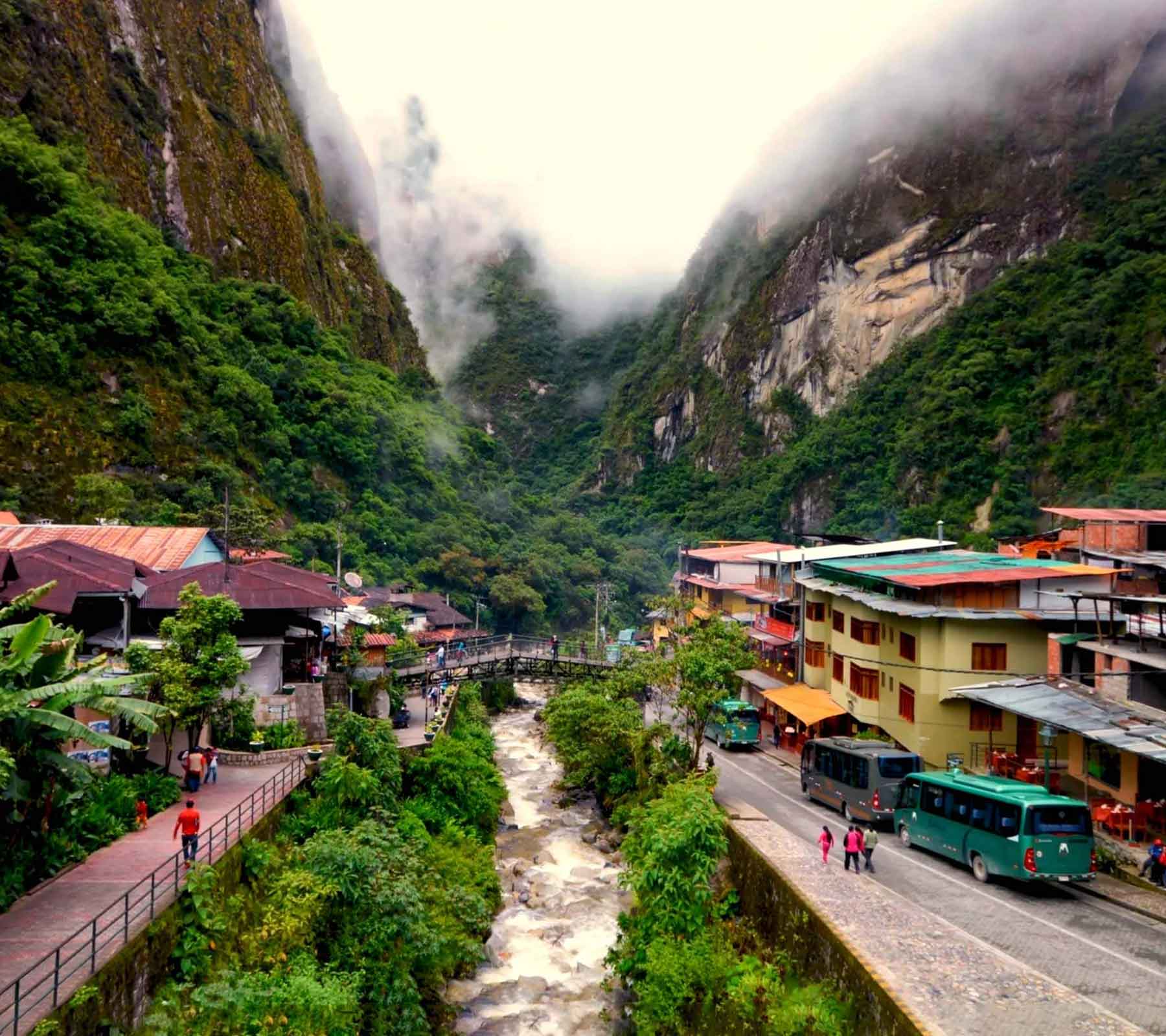
By bus
The first departure is at 5.30 am and the last departure is at 3.30 pm. The last bus leaves back at 17:30. Departures every 10 min. The price is $ 12 with return or $ 6 one-way. Some people prefer to walk up, others prefer to take the bus up and walk down.
The bus ticket to Machu Picchu can be purchased at the plaza in Cusco (Avenida Infancia 433) or Aguas Calientes (Avenida Hermanos Ayar S / N), online at the Consettur site.
Frequently Asked Questions
- When is the ideal time to visit Machu Picchu?
To enjoy a quieter experience, it is advisable to go very early, when the site opens at 6:00 a.m., and thus see the sunrise with fewer visitors. - What to bring to visit Machu Picchu?
Pack a small backpack with essential items: water, snacks, sunscreen, a hat, insect repellent, and a raincoat if it's rainy season. Wear layered clothing and comfortable footwear to adapt to changing weather and uneven terrain. Don't forget your ticket and passport. - Can you walk up from Aguas Calientes to Machu Picchu?
Yes, it is possible, but it requires good physical condition. The walk takes between 1.5 and 2 hours, with steep sections and many stairs through the forest. It is a demanding challenge, but with spectacular views. It is best to start very early and bring enough water. - Are there ATMs in Aguas Calientes or should I bring cash?
Although there are ATMs in the town, they can run out of money during high season. It is advisable to carry enough cash for expenses such as meals, tickets, or tips. If you decide to use an ATM, consider that commissions are usually high. - When to buy train tickets to Aguas Calientes?
During high season, it is essential to book several weeks in advance, as spaces sell out quickly. You can easily do it online, choosing the schedule and type of service you prefer. - Can tickets for Machu Picchu be bought in Aguas Calientes?
Yes, there is a sales office in the town. However, due to high demand (especially between May and September), it is recommended to purchase them online in advance to guarantee your entry. - Where do you buy bus tickets and where is the station in Aguas Calientes?
You can buy tickets online or directly in Aguas Calientes, near the main square. Buses start their service from 5:30 a.m. To avoid queuing on the same day, it is advisable to buy them in advance, preferably the day before. - Where to leave luggage while visiting Machu Picchu?
Most hotels in Aguas Calientes offer luggage storage at no additional cost. There are also lockers available near the entrance to Machu Picchu if you prefer to leave your belongings closer to the archaeological site. - Is it possible to hire a tour guide in Aguas Calientes?
Yes, you will find guides available near the bus station and at the entrance of Machu Picchu. - What is the weather like in Aguas Calientes and what kind of clothes to wear?
The climate is warm and humid. Between November and March it rains frequently, so it is important to bring a raincoat or poncho. From April to October the climate is drier, so it is recommended to wear light, breathable clothing, comfortable shoes, and a cap or hat. - How to best enjoy the hot springs of Aguas Calientes?
To avoid crowds, it is best to go early in the morning or at night. Bring your swimsuit, towel, and sandals; you can even rent a locker for convenience. - How to get to the Butterfly House and what does the visit offer?
The Butterfly House is about a 15-minute walk from the center, on the way to Machu Picchu. It is a serene space where you can observe native butterflies and learn about their life cycle.


